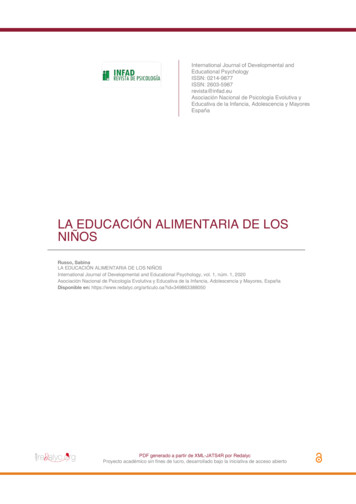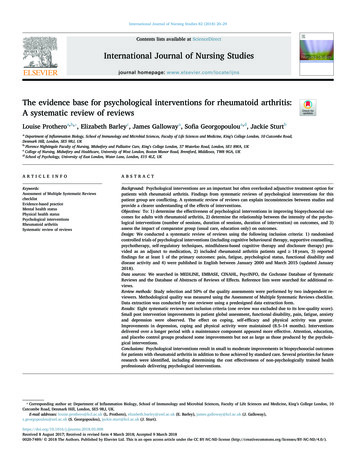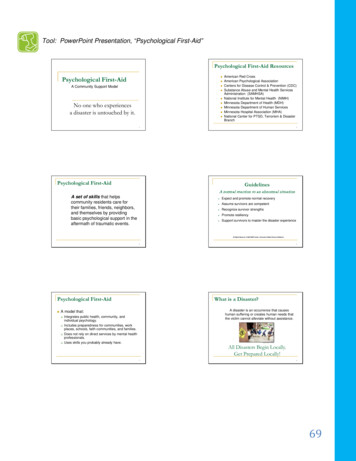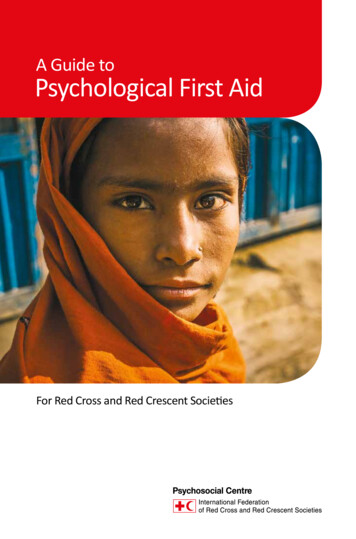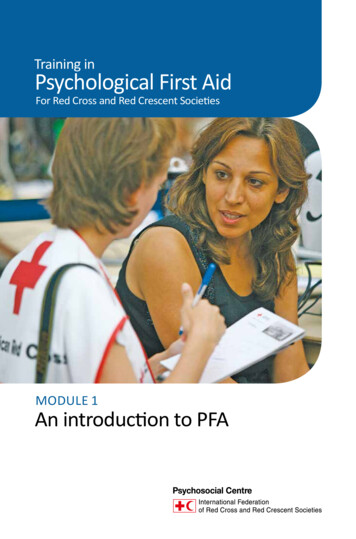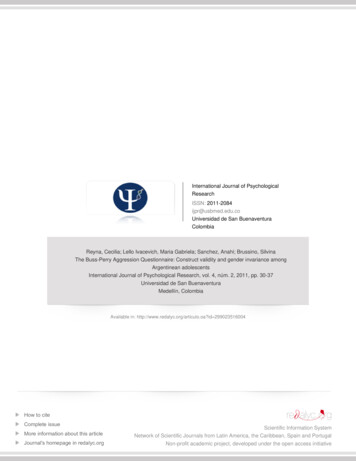
Transcription
International Journal of PsychologicalResearchISSN: 2011-2084ijpr@usbmed.edu.coUniversidad de San BuenaventuraColombiaReyna, Cecilia; Lello Ivacevich, Maria Gabriela; Sanchez, Anahi; Brussino, SilvinaThe Buss-Perry Aggression Questionnaire: Construct validity and gender invariance amongArgentinean adolescentsInternational Journal of Psychological Research, vol. 4, núm. 2, 2011, pp. 30-37Universidad de San BuenaventuraMedellín, ColombiaAvailable in: http://www.redalyc.org/articulo.oa?id 299023516004How to citeComplete issueMore information about this articleJournal's homepage in redalyc.orgScientific Information SystemNetwork of Scientific Journals from Latin America, the Caribbean, Spain and PortugalNon-profit academic project, developed under the open access initiative
International Journal of Psychological Research, 2011.Vol. 4. No. 2.ISSN impresa (printed) 2011-2084ISSN electrónica (electronic) 2011-2079Reyna, C., Lello, M.G., Sanchez, A., Brussino, S., (2011).The Buss-PerryAggression Questionnaire: Construct validity and gender invariance amongArgentinean adolescents. International Journal of Psychological Research, 4(2),30-37.The Buss-Perry Aggression Questionnaire: Construct validity andgender invariance among Argentinean adolescentsCuestionario de Agresión de Buss-Perry: validez de constructo e invarianza de género enadolescentes argentinosCecilia ReynaUniversidad Nacional de CórdobaConsejo Nacional de Investigaciones Científicas y Técnicas ArgentinaMaria Gabriela Lello IvacevichUniversidad Nacional de CórdobaAnahi SanchezUniversidad Nacional de CórdobaSilvina BrussinoUniversidad Nacional de CórdobaConsejo Nacional de Investigaciones Científicas y Técnicas ArgentinaABSTRACTThe Aggression Questionnaire (Buss & Perry, 1992) is one of the most used instruments to assess aggression; itincludes 29 items grouped into 4 factors. Furthermore, a reduced version of 12-item has been proposed (Bryant & Smith,2001), and it has also been examined by several researchers. Nevertheless, Latin-American samples have rarely beenincluded. In this study, exploratory and confirmatory models were evaluated among a sample of adolescents from Cordoba,Argentina (N 371). Moreover, internal consistency and gender invariance were examined. A 2-factor structure resulted inthe exploratory analysis, while 2- and 4-factor (short and long versions) structures showed acceptable fits in confirmatoryanalysis. In general, internal consistency was acceptable, and gender invariance was supported. Implications and limitationsare discussed.Key words:Aggression Questionnaire; adolescents; factor structure; gender invariance.RESUMENEl Cuestionario de Agressión (Buss & Perry, 1992) es uno de los instrumentos más utilizados para evaluar laaggression, comprende 29 ítems agrupados en 4 factores. Otros autores han propuesto una versión reducida de 12 ítems(Bryant & Smith, 2001), la cual ha sido examinada por diversos investigadores. Sin embargo, dichos estudios en rarasocasiones han comprendido muestras latinoamericanas. En este estudio, se evalúan modelos exploratorios y confirmatoriosen una muestra de adolescentes de la ciudad de Córdoba, Argentina (N 371). Además, se examina la consistencia interna yla invarianza de género. En el análisis factorial exploratorio, la estructura bifactorial ofreció el mejor ajuste; mientras queestructuras de 2 y 4 factores (versiones larga y corta) mostraron ajustes aceptables en análisis confirmatorios. En términosgenerales, la consistencia interna fue aceptable. Los resultados avalan la invarianza de género. Se discuten las implicanciasy limitaciones.Palabras clave:Cuestionario de Agresión; adolescentes; estructura factorial; invarianza de género.Artículo recibido/Article received:Septiembre142011/September 142011,Artículo aceptado/Article accepted:Septiembre 23 2011/September 23 2011Dirección correspondencia/Mail Address:Cecilia Reyna, Laboratorio de Psicología Cognitiva, Facultad de Psicología, UNC, Ciudad Universitaria - (5000) Córdoba, Argentina. E-mail: ceciliareyna@gmail.com /cereyna@psyche.unc.edu.arINTERNATIONAL JOURNAL OF PSYCHOLOGICAL RESEARCH esta incluida en PSERINFO, CENTRO DE INFORMACION PSICOLOGICA DE COLOMBIA,OPENJOURNAL SYSTEM, BIBLIOTECA VIRTUAL DE PSICOLOGIA (ULAPSY-BIREME), DIALNET y GOOGLE SCHOLARS. Algunos de sus articulos aparecen enSOCIAL SCIENCE RESEARCH NETWORK y está en proceso de inclusion en diversas fuentes y bases de datos internacionales.INTERNATIONAL JOURNAL OF PSYCHOLOGICAL RESEARCH is included in PSERINFO, CENTRO DE INFORMACIÓN PSICOLÓGICA DE COLOMBIA, OPENJOURNAL SYSTEM, BIBLIOTECA VIRTUAL DE PSICOLOGIA (ULAPSY-BIREME ), DIALNET and GOOGLE SCHOLARS. Some of its articles are in SOCIALSCIENCE RESEARCH NETWORK, and it is in the process of inclusion in a variety of sources and international databases.30International Journal of Psychological Research
International Journal of Psychological Research, 2011.Vol. 4. No. 2.ISSN impresa (printed) 2011-2084ISSN electrónica (electronic) 2011-2079INTRODUCTIONAggression is a personality trait that is related toantisocial behavior. Anderson and Bushman (2002) haveoffered an integrative explanatory framework foraggression, in which cognitive, emotional and personalvariables interact with situational and environmentalfactors. One of the most used instruments for its study is theAggression Questionnaire constructed by Buss and Perry(1992), which comprises 29 items grouped into four factors:physical aggression, verbal aggression, anger and hostility.The first two factors represent the instrumental component.Anger implies physiological activation and represents theemotional component, while hostility involves feelings ofopposition and injustice thus representing the cognitivecomponent. Apparently, anger acts as a psychologicalbridge connecting instrumental and cognitive components.In the original study, the male participants were moreaggressive considering the full scale, and also the physicaldimension. In the same direction, minor but significantdifferences were observed on verbal aggression andhostility subscales. However, men and women reportedsimilar levels of anger (Buss & Perry, 1992).This questionnaire has been validated in differentcountries and translated into several languages, includingSpanish, Italian, Dutch, Japanese, German, French, Slovakand Greek. Not all those studies have supported the 4-factorstructure originally proposed. Moreover, gender differenceshave not always been observed in the same dimensions.Although most studies support a tetra-factorstructure there are discrepancies with regard to the itemsincluded in each factor and the factor loadings and/orregression coefficients (e.g., García-León, Reyes, Vila,Pérez, Robles, & Ramos, 2002; Rodríguez, Peña, & Graña,2002). Moreover, some researchers have found better fitswith bi-factor (Maxwell, 2007; Williams, Boyd, Cascardi,& Poythress, 1996), tri-factor (Sommantico, Osorio,Parrello, De Rosa, & Donizetti, 2008), or penta-factorstructures (Castillón, Ortiz, & Vieco, 2004). Furthermore,Bryant and Smith (2001) have proposed a 12-item versionbased on intensively exploratory and confirmatory studies.That reduced version has shown an improvement fit in theBryant and Smith’s study, and it has also presentedacceptable psychometric properties in other studies (Ang,2007; Gallardo, Kramp, García, Pérez, & Andrés, 2006;Maxwell, 2007; Morales, Codorniu, & Vigil, 2005;Tremblay & Ewart, 2005; Vitoratou, Ntzoufras, Smyrnis,&Stefanis, 2009).One issue extensively investigated in relation toaggression is gender differences. In this regard, manystudies have inquired about that by means of theAggression Questionnaire. Males have consistently beenInternational Journal of Psychological ResearchReyna, C., Lello, M.G.,Sanchez, A., Brussino, S., (2011). The Buss-PerryAggression Questionnaire: Construct validity and gender invarianceamongArgentinean adolescents. International Journal of Psychological Research, 4(2),30-37.found to be more physically aggressive than women (e.g.,Andreu, Peña, & Graña, 2002; Buss & Perry, 1992;Tremblay &Ewart, 2005; for a review see Archer, 2004).However, evidence is less clear in other dimensions.Studies reporting gender differences on verbal aggressionhave shown a mixed pattern and small size effects (e.g.,Ang, 2007; Buss & Perry, 1992; García-León, Reyes, Vila,Pérez, Robles, & Ramos, 2002; Meesters, Muris, Bosma,Schouten, & Beuving, 1996; Sommantico et al., 2008;Vitoratou et al., 2009). Regarding to anger, differenceshave not always been observed, and where genderdifferences have been found, it has been in the womendirection (e.g., Andreu et al., 2002; Santisteban, Alvarado,& Recio, 2007; Sommantico et al., 2008; von Collani&Werner, 2005). Finally, gender differences in hostility haverarely been reported, with few and mixed differences (e.g.,Andreu et al., 2002; Buss & Perry, 1992; Maxwell, 2007).Nonetheless, the study of gender differences onlymakes sense if measurement invariance is confirmed, whichimplies that different groups interpret a construct in asimilar way (Byrne & Watkins, 2003). The structure of theAggression Questionnaire has shown to be invariant orpartially invariant with respect to gender, culture and age(Ang, 2007; Bryant & Smith, 2001; Fossati, Maffei,Acquarini, & Di Ceglie, 2003; Santisteban et al., 2007;Vitoratou et al., 2009).Purpose of researchPrevious findings about the AggressionQuestionnaire are not consistent with regard to the factorialstructure. Besides, gender differences have not always beenobserved along all dimensions. Based on that, and takinginto account the need for a reliable and valid instrument tomeasure aggression among Argentinean adolescents, in thisstudy we proposed to examine factor structure of theAggression Questionnaire through exploratory andconfirmatory models, testing also internal consistency.Furthermore, we proposed to evaluate gender invariancealong three factorial models.METHODParticipantsThe sample consisted of 371 adolescentsaged 12 to19 years (M 14.89; SD 1.97) attending to twopublic schools in the city of Cordoba (Argentina). Menwere 134 (M 14.96 years old, SD 1.94) and womenwere 237 (M 14.86 years old, SD 1.99). Selection wasnot random due to the accessibility to the population ofinterest. Participation was voluntary and anonymous.31
International Journal of Psychological Research, 2011.Vol. 4. No. 2.ISSN impresa (printed) 2011-2084ISSN electrónica (electronic) 2011-2079Measure and procedureThe Aggression Questionnaire (Buss & Perry,1992) is a 29-item scale that measure four aspects of humanaggression. Two Spanish versions have been published(Andreu, Peña, &Graña, 2002; Santisteban &Alvarado,2009). For this study, a pilot study was carried out in orderto obtain an understandable version to Argentineanadolescents. The sentences of both Spanish versions wereassessed by 5 adolescents who had to indicate the words orphrases that they did not understand, and in those cases theyhad to do suggestions. The final version was defined by theresearchers; minimum modifications were applied (seeAppendix). Participants were asked to rate each item usinga 5-point Likert-type scale (1 uncharacteristic of me, 5 very characteristic of me). The questionnaire was takencollectively in each course during a normal class day.AnalysisFirst, data were studied using usual exploratorytechniques (Hair, Black, Babin, & Anderson, 2009).Second, an exploratory factor analysis (EFA) wasconducted. Third, three models were evaluated throughconfirmatory factor analyses: A-model: 2-factor from EFA(27 items); B-model: 4-factor based on Buss and Perry(1992, 29 items); and C-model: 4-factor based on Bryantand Smith (2001, 12 items). Also, reliability was tested foreach model. Finally, invariance gender was evaluated. Foreach of the models previously considered a hierarchical setof steps was carried out (Byrne & Stewart, 2006). Inparticular, a base model was tested separately foreach gender, and then configural, metric and stronginvariance were examined (Jöreskog & Sörbom, 2006).Analyses were conducted using the following software:SPSS 18, LISREL 8.8, and R 2.11.RESULTSAn initial analysis showed no univariate ormultivariate atypical cases (Hair et al., 2009). Acrossvariables, items presented adequate ( 1) or acceptable( 1.6) values for asymmetry and kurtosis (Table 1).Exploratory factor analysisWe used a principal axis factoring method in thesame way that studies of the original version. The KaiserMayer-Olkin (KMO) measure of sampling adequacy was0.884, and Bartlett's test of sphericity was significant (χ2approx. (406, N 371) 2753.699, p .000), whichsupported the factorial study. An initial solution suggested8 factors to be retained with eigenvalues greater than 1 thataccounted for 55.61% of the total variance. However, thescreeplot and Horn's parallel analysis suggested retaining 232Reyna, C., Lello, M.G., Sanchez, A., Brussino, S., (2011).The Buss-PerryAggression Questionnaire: Construct validity and gender invariance amongArgentinean adolescents. International Journal of Psychological Research, 4(2),30-37.factors. Consequently, solutions from 2 to 4 factors wereanalyzed, looking for the most parsimonious and theoreticalrelevant structure.Oblimin rotation was used because thefactors were assumed to be correlated. The Solution with 2factors was selected: Factor 1 included items of PhysicalAggression, Verbal Aggression, and Anger; and Factor 2included items of Hostility, Verbal Aggression, and Anger.Items 3 and 24 showed low communality and factorloading, so they were not included in posterior analysis(Table 1).Table 1.Descriptive statistics and factor structure of theAggressive osisItem 12.151.230.92-0.050.637Item 52.691.540.36-1.340.664Item 93.161.60-0.06-1.570.726Item 131.871.251.320.580.575Item 172.801.570.27-1.460.539Item 212.271.510.83-0.830.617Item 243.591.56-0.60-1.21Item 271.781.271.581.220.585Item 292.191.470.91-0.650.3990.234Item 22.771.280.44-0.810.3730.183Item 62.561.240.59-0.580.1290.339Item 102.991.400.14-1.260.4180.104Item 142.451.310.69-0.600.410.23Item 181.951.341.240.210.3040.272Item 33.461.39-0.29-1.220.2040.142Item 73.351.39-0.17-1.30Item 113.261.42-0.17-1.270.251Item 152.371.370.53-1.040.382Item 192.311.390.78-0.640.3360.289Item 222.611.480.44-1.220.2460.429Item 252.591.530.50-1.240.1780.333Item 41.630.911.320.710.321Item 83.251.49-0.19-1.380.378Item 122.811.510.27-1.360.575Item 162.621.440.43-1.140.628Item 202.491.490.55-1.130.468Item 233.481.45-0.39-1.230.431Item 262.871.510.22-1.420.619Item 283.021.490.07-1.420.368Factor 1Factor 2-0.19-0.1170.3750.467International Journal of Psychological Research
International Journal of Psychological Research, 2011.Vol. 4. No. 2.ISSN impresa (printed) 2011-2084ISSN electrónica (electronic) 2011-2079Reyna, C., Lello, M.G.,Sanchez, A., Brussino, S., (2011). The Buss-PerryAggression Questionnaire: Construct validity and gender invarianceamongArgentinean adolescents. International Journal of Psychological Research, 4(2),30-37.Confirmatory factor analysisMaximum likelihood method was used.Correlations were allowed between errors within eachsubscale, and factors were also correlated. The followinggoodness-of-fit measures were considered: a) absolute fitindexes: chi-square statistic, goodness of fit index (GFI)and adjusted GFI (AGFI), and standardized root-meansquare residual (SRMR); b) comparative fit indexes:comparative fit index (CFI) and non-normed fit index(NNFI); and c) parsimonious fit indexes: mean square errorof approximation (RMSEA), parsimony normed fit index(PNFI), parsimony goodness of fit index (PGFI), andAkaike information criteria (AIC) (for further explanationssee Brown,2006; Hu & Bentler, 1999; Shumacker& Lomax, 2004). While the χ2 statistic indicates theabsolute fit of the model, it is sensitive to sample size andviolations of multivariate normality assumption; hence it isrecommended that other indices of adjustment are alsoconsidered.The A and B models shown a bad fit according toχ2 statistic (A: χ2(297, N 371) 460.55, p .00; B:χ2(366, N 371) 680.81, p .00). Following therecommendations to consider multiple indicators, it wasobserved that both models presented a relatively bad oracceptable fit as other criteria of absolute fit; while anacceptable fit was observed according to comparative andparsimonious indexes (Table 2). In the A model the rangeof standardized regression coefficients was .32-.63 in factor1, and .29-.66 in factor 2. In the B model they ranged from.55 to .70 in physical aggression (except for item 24), .44 to.68 in verbal aggression, .27 to .67 in anger, and .35 to .63in hostility. The B model showed an adequate fit accordingto all considered indexes, including the χ2 statistic (χ2(47, N 371) 63.42, p .055) (Table 2). In this model,standardized regression weights ranged from .53 to .71 inphysical aggression, .47 to .65 in verbal aggression, .31 to.69 in anger, and .40 to .66 in hostility.Table 2.Goodness-of-fit indices for different models of the Aggression FI PGFIAICA- EFA460.55297 0.920.890.0490.980.970.0380.790.72614.07B- Buss & Perry (1992)680.81** 366 .990.980.0270.680.59121.74C- Bryant & Smith (2001)63.42*470.97Note. GFI: goodness of fit index; AGFI: adjusted GFI; SRMR: standardized root-mean-square residual; CFI: comparative fit index; NNFI:non-normed fit index; RMSEA: mean square error of approximation; PNFI: parsimony normed fit index; PGFI: parsimony goodness of fitindex; AIC: Akaike information criteria.*p .06. **p .00.Internal consistencyWith regard to reliability, internal consistency wasevaluated by means of Cronbach’s alpha (α). Indicesbetween .70 and .80 are considered good reliabilityestimates (Kaplan & Sacuzzo, 2006), whereas it isacceptable a lower value (around .60) on scales that meetcertain criteria (Loewenthal, 2001). In that sense, the Amodel showed good indices for the total scale, and also forsubscales. The B and C models showed good indices for thetotal scale, while for subscales indices were good,acceptable or low (see Table 4).compare nested models ΔCFI and Δχ2 criteria were used(Byrne & Stewart, 2006, Cheung &Rensvold, 2002). In theA model both structures showed an acceptable fit. Whilethe results were similar when examining configural andmetric invariance, Δχ2 and CFI indicated oppositeconclusions, according to the first invariance is notsatisfied, and according to the second it is satisfied. In the Bmodel results were similar to those observed in the Amodel. And in the C model not only both gender showed anadequate fit but both configural and metric invariance weresupported. As expected, none of the models supportedstrong invariance, which means that latent means of menand women are different.Gender invarianceConfirmatory factor analyses were carried out foreach considered model. Maximum likelihood method wasused, and the same correlations between errors as thoseobserved in previous models were allowed. Table 3contains fit results for each model. The following indiceswere considered: χ2, CFI, RMSEA, and AIC. In order toInternational Journal of Psychological ResearchIn order to compare men with women on eachsubscale and total scale t-tests were developed. Menshowed higher values of physical aggression than womenaccording to B (t(369) 2.95, p .003, d 0.32) and C(t(369) -2.9, p .004, d 0.32) models. Moreover,women showed higher values of anger according to the Bmodel (t(369) 2.22, p .027, d 0.24). However, the33
International Journal of Psychological Research, 2011.Vol. 4. No. 2.ISSN impresa (printed) 2011-2084ISSN electrónica (electronic) 2011-2079Reyna, C., Lello, M.G., Sanchez, A., Brussino, S., (2011).The Buss-PerryAggression Questionnaire: Construct validity and gender invariance amongArgentinean adolescents. International Journal of Psychological Research, 4(2),30-37.effect size in both cases was small. No other genderdifferences were found (Table 4).Table 3. Goodness-of-fit indices for different models of theAggression n424.022970.970.039566.59Conf. Inv.832.895940.970.0421109.32Metric Inv.905.886450.960.0411071.47ModelCFI RMSEAAICΔχ2 CFIA- EFAStrong Inv.B- Buss &Perry 3660.960.046683.88Conf. Inv.1067.137320.950.0461293.18Table 4. Internal consistency, means, standard deviations,and effect size estimates for different models of theAggression Questionnaire.Model72.99*1280.93 200.72507.9sample of Spanish preadolescents. Beyond that, it isremarked that not all studies have used the same extractionand rotation methods, consequently comparisons should betaken with caution.***Metric Inv.1118.527620.950.0461273.31Strong Inv.C-Bryant &Smith(2001)Men1542.188160.90.0691765.21 990.022114.39Conf. Inv.110.14940.990.022226.54Metric Inv.123.261030.990.026221.67Strong Inv.235.831230.920.07349.61 112.57***13.12Men(n 134)Women(n 237)MSDMSDd-0.01A- EFA-0.02Total0.88370.0918.1870.3819.38-0.02Factor 10.85334.8110.4633.1312.010.15Factor 2B- Buss & Perry(1992)TotalPhysicalAggressionVerbal 6-0.32*HostilityC- Bryant &Smith (2001)TotalPhysicalAggressionVerbal 0.07Note. CFI: comparative fit index; RMSEA: mean square error ofapproximation; AIC: Akaike information criteria. Conf. configurational; Inv. invariance.*p .05. **p .01. ***p .000.Note. α: Cronbach’s alpha. *t-values p 0.05.DISCUSSIONThis study examined psychometric properties ofthe Aggression Questionnaire in a sample of Argentineanadolescents. In general, results have shown a similarstructure for men and women. Even though items appear beunderstood and answered in a similar way, different resultswere observed for each model and index considered.Reduced version of 12-items presented the best fit.An initial exploratory factor analysis failed toreplicate the 4-factor structure commonly reported; a 2factor model showed a better fit. As noted earlier, the 4factor structure has not always offered a good fit. Forinstance, Williams et al. (1996) found that a 2-factorstructure presented a best fit for U.S. adult offenders. Byother hand, some authors have considered excluding someproblematic items (Harris, 1995; Meesters et al., 1996;Nakano, 2001). In particular, Santisteban et al. (2007)observed that items 3 and 24 had low factor loadings in a34The model obtained in the exploratory factoranalysis and the original and shortened models of theAggression Questionnaire were submitted to confirmatoryfactor analysis. In general, all three models presented agood fit. These results agree with the report of Morales etal. (2005), they indicated that both original and short formsof the Aggression Questionnaire presented a good fit in aheterogeneous sample of Spanish. Besides, studies withsamples from other countries such as China, Canada andGreece showed that the short version offered a better fit(Maxwell, 2007; Tremblay & Ewart, 2005; Vitoratou et al.,2009).Regarding to internal consistence, good indiceswere obtained for most of full and subscales versions. Aswas expected, the short version showed the lowest values ofinternal consistency. In general, previous findings havereported good properties of internal consistency. However,some studies have found low indices in some dimensionsInternational Journal of Psychological Research
International Journal of Psychological Research, 2011.Vol. 4. No. 2.ISSN impresa (printed) 2011-2084ISSN electrónica (electronic) 2011-2079(Ang, 2007; Meesters et al., 1996; Morren & Meesters,2002; Ramirez, Andreu, & Fujihara, 2001). For the shortversion, an obvious explanation is the limited number ofitems, while other factors such as culture or age can perhapsalso explain those results.These findings indicate that the structure of theAggression Questionnaire appears to be similar for bothmen and women; items are similarly interpreted andanswered. However, the short version appeared to show aslightly better fit. Furthermore, gender differences foundare in line with what is mostly stated in the literature.Gender differences observed in only some dimensionshighlights the multiple facets of aggression. There isconsiderable agreement on the differences in physicalaggression, and these results supported it. However,differences in anger have been only sometimes reported. Itsuggests that the expression of cognitive and emotionalcomponent of aggression might be different across culturesand age.The main limitation of this study was the samplesize and the sampling method. This sample might not berepresentative of Cordoba adolescents. Hence, furtherstudies should seek to obtain probabilistic and moreheterogeneous samples, thereby to facilitate thegeneralizability.This study was a first approximation to thepsychometric properties of the Aggression Questionnaireamong Argentinean adolescents. Considering the multiplerelations of aggression to other variables such as academicperformance, drug use and other personality constructs(e.g., sensation seeking and impulsivity) (Anderson &Bushman, 2002), studies that address these relationshipswould provide evidence of predictive and convergentvalidity. In addition, taking into account the relatively goodcharacteristics of the short version, and its advantages to beincluded within larger battery of items, it is recommendableto examine more in detail its properties. These findingshighlighted therelevanceofadapting instrumentsconstructed or employed in countries with differentcultures to the target population (Hambleton, 2001;Poortinga, 2000).REFERENCESAnderson, C. A., & Bushman, B. J. (2002). Humanaggression. Annual Review of Psychology, 53, 2751.Andreu, J. M., Peña, M. E., & Graña, J. L. (2002).Adaptación psicométrica de la versión españoladel Cuestionario de Agresión. Psicothema, 14(2),476-482.International Journal of Psychological ResearchReyna, C., Lello, M.G.,Sanchez, A., Brussino, S., (2011). The Buss-PerryAggression Questionnaire: Construct validity and gender invarianceamongArgentinean adolescents. International Journal of Psychological Research, 4(2),30-37.Ang, R. P. (2007). Factor structure of the 12-itemaggression questionnaire: Further evidence fromAsian adolescent samples. Journal of Adolescence30(4), 671-685.Archer, J. (2004). Sex differences in aggression in realworld settings: A meta-analytic review. Review ofGeneral Psychology, 8(4), 291-322.Brown, T. A. (2006). Confirmatory factor analysis forapplied research. New York: The Guilford Press.Bryant, F. B., & Smith, B. D. (2001).Refining thearchitecture of aggression: A measurement modelof the Buss-Perry Aggression Questionnaire.Journal of Research in Personality, 35(2) 138-167.Buss, A. H., & Perry, M. (1992). The AggressionQuestionnaire. Journal of Personality and SocialPsychology, 63(3), 452-459.Byrne, B. M., & Stewart, S. M. (2006). The MACSapproach to testing for multigroup invariance of asecond-order structure: A walk through theprocess. Structural Equation Modeling, 13(2),287-321.Byrne, B. M., & Watkins, D. (2003). The issue ofmeasurement invariance revisited. Journal ofCross-cultural Psychology, 34(2), 155-175.Castillón, D. A., Ortiz, P. A., & Vieco, F. (2004).Cualidades paramétricas del cuestionario deagresión (AQ) de Buss y Perry en estudiantesuniversitarios de la ciudad de Medellín(Colombia). Revista Facultad de Salud Pública,22(2), 49-61.Cheung, G. W., &Rensvold, R. B. (2002). Evaluatinggoodness-of-fit indexes for testing measurementinvariance. Structural Equation Modeling, 9(2),233-255.Fossati, A., Maffei, C., Acquarini, E., & Di Ceglie, A.(2003). Multigroup confirmatory component andfactor analyses of the Italian version of theAggression Questionnaire. European Journal ofPsychological Assessment, 19(1), 54-65.Gallardo, D., Kramp, U., García, C., Pérez, M., & Andrés,A. (2006). Assessing aggressiveness quickly andefficiently: the Spanish adaptation of chiatry, 21(7), 487-494.García-León, A., Reyes, G.A., Vila, J., Pérez, N., Robles,H., & Ramos, M. M. (2002). The AggressionQuestionnaire: A validation study in studentsamples. Spanish Journal of Psychology, 5(1), 4553.Gerevich, J., Bácskai, E., & Czobor, P. (2007). Thegeneralizability of the Buss–Perry AggressionQuestionnaire. International Journal of Methods inPsychiatric Research, 16(3), 124-136.35
International Journal of Psychological Research, 2011.Vol. 4. No. 2.ISSN impresa (printed) 2011-2084ISSN electrónica (electronic) 2011-2079Hair, J. F., Black, W. C., Babin, B. J., & Anderson, R. E.(2009). Multivariate data analysis (7th ed.). UpperSaddle River, NJ: Prentice Hall.Harris, J. A. (1995). Confirmatory factor analysis of theaggression questionnaire. Behaviour Research andTherapy, 33(8), 991-993.Hambleton, R. K. (2001). The next generation of the ITCtest translation and adaptation guidelines.European Journal of Psychological Assessment,17, 164-172.Hu, L. & Bentler, P. M. (1999). Cutoff criteria for fitindexes in covariance structure analysis:Conventional criteria versus new alternatives.Structural Equation Modeling, 6(1), 1-55.Jöreskog, K. & Sörbom, D. (2006).LISREL 8.80 forWindows [Computer Software].Lincolnwood, IL:Scientific Software International, Inc.Kaplan, R. M., & Saccuzzo, D. P. (2006). Pruebaspsicológicas: Principios, aplicaciones y temas (6aed.). Mexico: Thomson Learning.Loewenthal, K. M. (2001). An introduction topsychological tests and scales (2nd ed.
Second, an exploratory factor analysis (EFA) was conducted. Third, three models were evaluated through confirmatory factor analyses: A-model: 2-factor from EFA (27 items); B-model: 4-factor based on Buss and Perry (1992, 29 items); and C-model: 4-factor based on Bryant and Smith (2001, 12 items). Also, reliability was tested for




